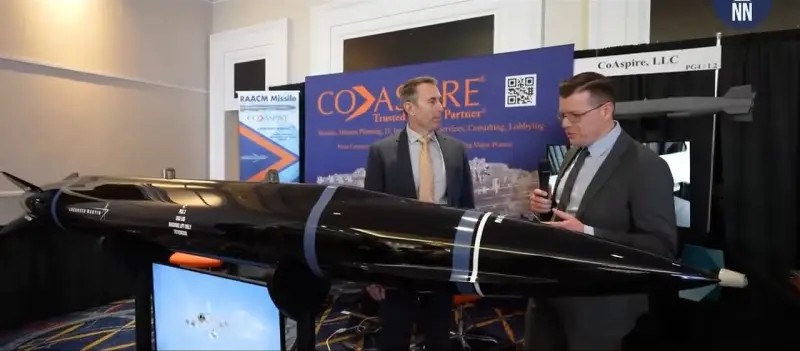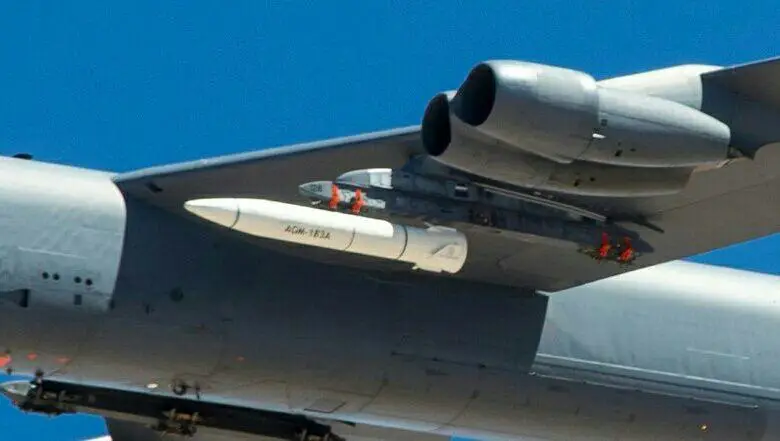Lockheed Martin and CoAspire hypersonic Mako for F-35

Mako rocket mockup at the CoAspire stand
Lockheed Martin is one of the main participants in the American hypersonics program. Recently, she presented her latest development in this area - a rocket coded Mako. This project was created on a proactive basis using previously accumulated experience. It is alleged that the development of the new ammunition is coming to an end, and in the very near future it will be possible to begin both testing and mass production of promising products.
Premiere in Moscow
Previously, Lockheed Martin did not report the presence of another project for a promising hypersonic missile system. The Mako project was presented only recently, in early April, at the Sea Air Space 2024 conference. As part of this exhibition, a life-size model of the future rocket was demonstrated, they said history project and disclosed other data. In addition, they showed an animated video showing the combat use of a missile by a fighter aircraft.
The history of the Mako project reportedly began in the middle of the last decade - when the US Air Force launched a program to develop a hypersonic missile for tactical aviation Stand In Attack Weapon (SiAW). A joint application for participation in the program was submitted by Lockheed Martin and CoAspire, which have some experience in the hypersonic field. Their project became one of the finalists in the SiAW program, but could not win - the contract was eventually awarded to Northrop Grumman.
However, Lockheed Martin and CoEspire did not stop and continued to develop their project proactively, counting on the attention of other potential customers. Despite the lack of support from the Pentagon, the companies have now almost completed the design work and are ready to move on to the next stage.
In addition, the developers decided that at the current stage the product can be presented to specialists and the public. The presentation of the new project took place at the recent Sea Air Space 2024 exhibition. It is curious that the layout and materials for the project were placed at the CoAspire stand.
At a recent exhibition, it was reported that the Mako rocket is almost ready for flight testing. These activities may begin very soon. In addition, Lockheed Martin is ready to prepare and launch a production line in the shortest possible time. The exact timing of testing and launch of the series depends on the presence or absence of interest from potential buyers, as well as pre-orders.

Demonstration of externally mounted missiles, still from promotional video
Technical appearance
Unfortunately, there is not too much information about the Mako missile yet. The developers showed the appearance of the product and also named some of its features. At the same time, the most interesting design features and parameters remain unknown.
The Mako product is a high-precision hypersonic air-to-surface missile designed to destroy air defense systems, strike systems, command posts, ships, etc. The presented version of the missile is intended for use in aviation, but the possibility of creating other versions of the missile system is being considered.
The missile has an elongated body and looks little different from other aircraft weapons. The body has an ogival nose fairing, and the tail of the rocket is equipped with X-shaped air rudders. On the main part of the body there is a garrot, which contains fastenings for suspension on standard aircraft beam holders.
The dimensions and weight of the product are unknown. At the same time, the developers mention that the Mako fits into the internal cargo compartment of the F-35 fighter. This means that the length of the rocket does not exceed 12 feet (approx. 3,7 m), and the diameter and span of the planes are limited to 630-650 mm. At the same time, external suspension is not excluded.
Apparently, the Mako missile is structurally divided into an engine stage and a hypersonic warhead. The main volume of the body must be given over to a solid fuel charge, which ensures acceleration to the required speed and placement on the desired trajectory. Flight speeds are not specified. Development companies are limited to the standard wording “more than 5 M”.
The missile can carry a hypersonic gliding warhead. This product is capable of flying at high speed and performing maneuvers. The unit must have means of targeting the target, but their type is not reported. The possibility of using seekers of various types to obtain maximum combat qualities is mentioned. The combat load and flight parameters of a hypersonic aircraft are also unknown.

Resetting the Mako from the internal compartment, still from the promotional video
At the moment Mako is considered as an aviation weapons. This missile is proposed to be included in the ammunition load of all current US Air Force and Navy fighters. Unlike older aircraft, the F-22 and F-35 aircraft will be able to carry such weapons in internal cargo bays. The possibility of placing the missile on other platforms - on a ground chassis, on ships and on submarines - is not excluded.
With unclear prospects
Lockheed Martin and CoAspire announce the completion of the design of the new Mako hypersonic missile and the possibility of speedy testing and launch of the series. They show enviable optimism, but the real prospects of the project remain unknown. There is no information about any potential customers, and the technical and other features of the project do not allow us to make unambiguous forecasts.
From the disclosed data it follows that the Mako project has a number of strengths that should attract the attention of future buyers. First of all, this is the class of the missile, which determines its technical and combat characteristics. The new hypersonic weapon is intended for tactical aviation and should dramatically increase its potential. At the same time, compatibility with all current media is ensured, incl. from the point of view of placement on the internal suspension.
The exact tactical and technical characteristics of the Mako have not yet been disclosed. In particular, the flight range and combat radius of the strike complex as a whole remain unknown. Nevertheless, it is clear what the speed of the new rocket can be and what advantages it will provide. In general, we are talking about all the advantages characteristic of hypersonic weapons.
However, Mako should not be overestimated. There are a number of factors that hinder the successful implementation of this project, and because of them, the new missile from Lockheed Martin and CoEspire may remain a purely exhibition model.

AGM-183A missile during testing
The main problems with the Mako project are related to its complexity. Developing a hypersonic missile with the required level of performance and acceptable reliability is a very difficult task. In the case of the Mako, new challenges arise due to the small size and weight of the structure. Whether the two companies actually succeeded in creating a compact rocket with the required reliability is unclear.
Lockheed Martin does have extensive experience in the field of hypersonic technologies, but it cannot be called positive. Thus, the AGM-183A ARRW aeroballistic hypersonic missile project did not live up to expectations and was closed, and some other developments did not progress beyond design and testing. In this regard, it is not clear whether Lockheed Martin really has the competence and experience to create real hypersonic weapons.
The chosen niche for the new sample also raises questions. Adoption into tactical aviation implies mass production and active combat use. At the same time, hypersonic products are not simple and cheap. Not every potential customer will be able to find the means to form large enough arsenals of Mako or other similar weapons.
It should also be recalled that the main American hypersonic weapons projects, incl. brought to testing, were developed by order of the Pentagon. Initiative projects cannot yet boast of such successes. Lockheed Martin and CoAspire are likely planning to change this, but success is not guaranteed.
Demonstration of opportunities
Thus, two American companies, having accumulated useful experience, have developed a promising model of hypersonic weapons and are ready to demonstrate it at public events. In addition, there is talk about the possibility of soon carrying out flight tests and starting production. At the same time, the exact dates for the start of flights or shipment of the first production batch are not announced, as are the main tactical and technical characteristics, etc.
At the moment, the Mako project looks interesting and we can even talk about certain prospects. However, it should not be overestimated. So far, everything looks like an attempt to demonstrate the possibilities of finding a client who will pay for further work and, if successful, will be able to receive new weapons. The process of such a search began several weeks ago, and its prospects remain unknown.
Information